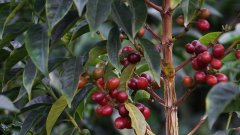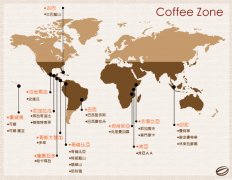Origin of Colombia Coffee Bean Origin of Colombia Coffee Bean Boutique Coffee
The world's largest producer of premium coffee!
Traditional dark roast coffee has a strong and nostalgic flavor
Coffee was first introduced to Colombia in 1808 by a priest from the French Antilles via Venezuela. Today the country is the second largest producer after Brazil, producing 13 million bags per year at 60 kg, compared to Brazil's 22 million bags. The status of coffee in Colombia is illustrated by the fact that all vehicles entering the country must be sprayed to avoid inadvertent disease and damage to coffee trees.
Colombia coffee is one of the few plain coffees sold worldwide under its name. In terms of quality, it has earned accolades that no other coffee can match. The country is the world's largest exporter of arabica coffee beans, while robert coffee is rarely grown. It is also the world's largest exporter of washed beans. Colombia is more concerned with product development and production promotion than other producing countries. It is this, coupled with its superior geographical and climatic conditions, that makes Colombia coffee delicious and famous all over the world.
The coffee-producing region of the country is located in the foothills of the Andes, where the climate is mild and the air humid. Colombia has three Cordilleras (sub-mountain system) running north-south, right into the Andes. Coffee is grown along the highlands of these mountains. The terraces provide a diverse climate, which means that harvest season occurs throughout the year and different types of coffee ripen at different times. And fortunately, unlike Brazil, Colombia doesn't have to worry about frost damage. There are approximately 2.7 billion coffee trees in Colombia, 66 per cent of which are grown in modern plantations and the rest in small, traditionally managed farms.
In the early 1960s, coffee production was about 600 kg per hectare, but now it has increased to about 900 kg, and individual farms can reach 2500 kg. However, quality assurance is the primary concern of the coffee industry. In 1927, Colombia established the Federación Nacional de Cafeteros (FNC), responsible for quality control. Although the association is a private company, it acts on behalf of the Government. In addition to organizing the industry, the association is responsible for raising funds in bumper years. Coffee prices have tended to fall over the past few years, and the association has nearly exhausted its reserves. INCA is also responsible for health care, education, road construction, hiring plant technicians, conducting surveys, monitoring product quality, directly handling 50 per cent of exports, hiring marketing personnel, etc. Like Kenya's National Coffee Management Association, it is a model for coffee organizations.
Coffee farmers in Colombia can sell all their produce to the Coffee Management Association at the official low price or to exporters, who may offer higher prices or not bid at all. In effect, the Coffee Control Council (FNC) controls exports to Europe, while coffee exports to the United States are mainly made through private exporters. However, all exports are subject to minimum export prices.
Colombia is fortunate to have Atlantic and Pacific ports, which help to reduce the cost of transporting coffee, and it is the only country in South America that has this condition. The main productive areas of Colombia are located in the Central and Eastern Mountains. The most important plantations along the central mountain range are located in Medellin, Armenia and Manizales. Of the three regions mentioned above, Medellin produces the best coffee quality and high prices, characterized by full grains, rich nutrients, strong aroma and moderate acidity. These three regions are referred to as MAM(the initials of the names of the major cities in the three regions). MAM is the origin of most of Colombia's top coffee for export. Along the eastern mountains, the two best areas are around Bogotá and further north around Bucaramanga. Bogotá coffee is less acidic than Medellin coffee, but the quality is comparable.
German imports account for 25 per cent of Colombia's total exports, which also reflects the country's excellent quality. Coffee grades are divided into three grades: Supreme (Supremo), Excellent (Excelso) and Excellent (UGQ, Unusual Good Quality). Klauss coffee in the excellent grade is exported to Germany, and Europa coffee is exported to Nordic countries. Excellent coffee and premium coffee are available in most coffee shops. The difference between the two professional regulations is that the coffee beans used in the top coffee are larger, and the raw materials are taken from the newly harvested coffee beans, which makes it easier to ensure the quality of the product. Premium coffee is usually softer and slightly more acidic than premium coffee, but both are aromatic coffees with moderate particles and excellent fruit. Colombia coffee is often described as having a silky smooth taste, and of all coffees, it is the best balanced, soft, smooth and ready to drink.
The thorny question facing Colombia coffee growers is whether to replace bourbon coffee trees with fast-growing and high-yield arabica coffee trees. Some say the quality will not be as good as it used to be, but others say there will be little difference in quality where coffee grows best

Important Notice :
前街咖啡 FrontStreet Coffee has moved to new addredd:
FrontStreet Coffee Address: 315,Donghua East Road,GuangZhou
Tel:020 38364473
- Prev

Alpine coffee from Guatemala. If Manning's taste tendency is "male", it is dangerous.
Guatemala SHB: alpine coffee from Guatemala. If Mantenin's taste tends to be male, Guatemalan coffee is female. With sweetness similar to caramel or chocolate and sour taste of blueberries or raspberries, the bitterness is not obvious. The taste is just right, and if it is brewed properly, it will be a very elegant cup. One of my favorite coffee beans.
- Next

Tanzanian coffee named after Mount Kilimanjaro
Tanzania AA Kilimanjaro: Tanzanian coffee named after Mount Kilimanjaro. It is very popular in Japan and the United States. The taste tends to be similar to Kenyan coffee, but it is more sour and bitter and more barbaric. It's a little too sour for me, but there are also people who love sour coffee who drink Kilimanjaro.
Related
- Does Rose Summer choose Blue, Green or Red? Detailed explanation of Rose Summer Coffee plots and Classification in Panamanian Jade Manor
- What is the difference between the origin, producing area, processing plant, cooperative and manor of coffee beans?
- How fine does the espresso powder fit? how to grind the espresso?
- Sca coffee roasting degree color card coffee roasting degree 8 roasting color values what do you mean?
- The practice of lattes: how to make lattes at home
- Introduction to Indonesian Fine Coffee beans-- Java Coffee producing area of Indonesian Arabica Coffee
- How much will the flavor of light and medium roasted rose summer be expressed? What baking level is rose summer suitable for?
- Introduction to the characteristics of washing, sun-drying or wet-planing coffee commonly used in Mantenin, Indonesia
- Price characteristics of Arabica Coffee Bean Starbucks introduction to Manning Coffee Bean Taste producing area Variety Manor
- What is the authentic Yega flavor? What are the flavor characteristics of the really excellent Yejasuffi coffee beans?

